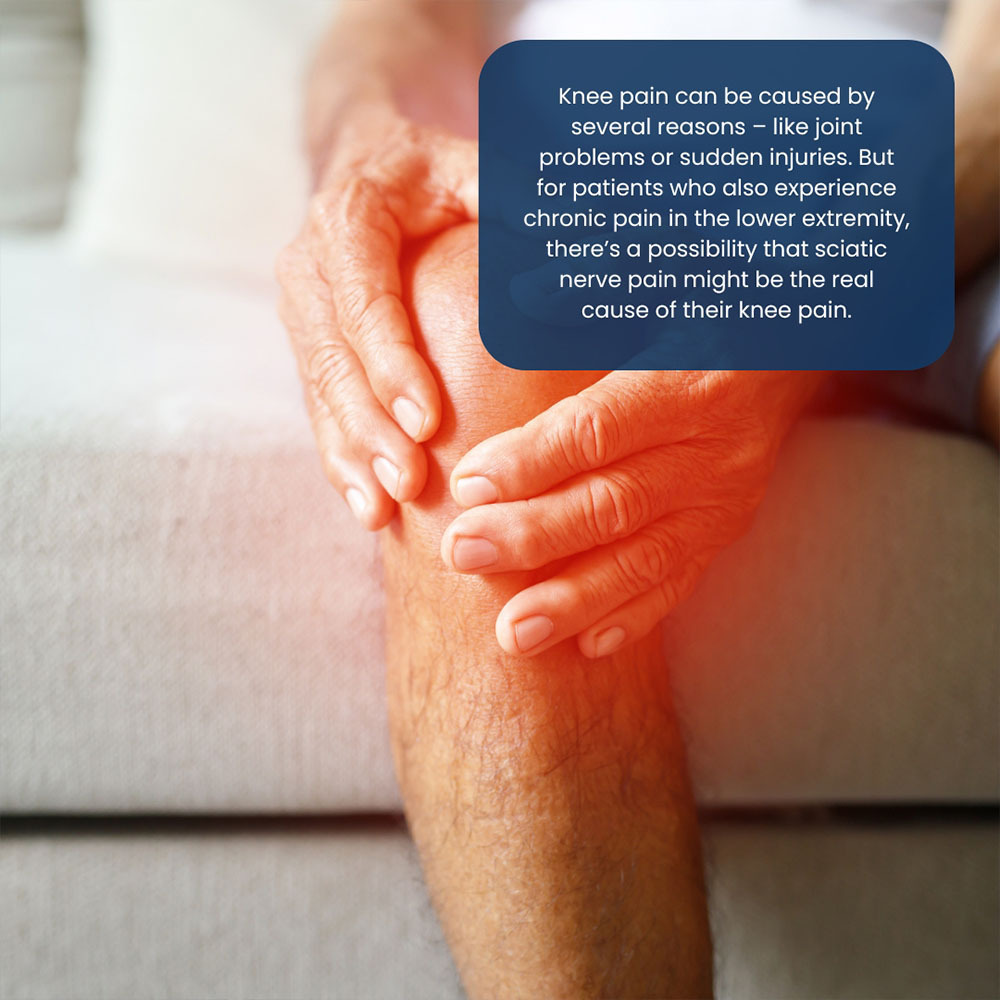 OUR LOCATIONSCall to book (212) 604-1300
OUR LOCATIONSCall to book (212) 604-1300
 OUR LOCATIONSCall to book (212) 604-1300
OUR LOCATIONSCall to book (212) 604-1300

Knee pain can be caused by several reasons – like joint problems or sudden injuries. But for patients who also experience chronic pain in the lower extremity, there’s a possibility that sciatic nerve pain might be the real cause of their knee pain.
So is sciatica the reason for the pain in your knee? If your knee hurts even though you have no knee-related injury, then you might be suffering from sciatica-related knee pain. Some of the common symptoms of sciatica-related knee pain include shooting pain or burning sensation from the lower back, weakness or numbness in the back of the leg, or pain when changing positions.
Sciatica (or lumbar radiculopathy) is a type of pain that affects about 10% to 40% of the population. People become more likely to experience sciatica pain as they get older because it’s often associated with spine conditions.
The sciatic nerve is the largest and longest nerve in the body that starts from the lower back and extends to the lower extremity of a person. When a part of the sciatic nerve becomes pinched or irritated, patients feel lower back pain that extends to one side of the hip, thigh, lower leg, and foot.
Since a branch of the sciatic nerve called the peroneal nerve is found just below the knee, patients can experience sciatic nerve pain in that area. If you have chronic pain that isn’t caused by any knee injury, then the cause might be a pinched nerve or sciatica in your lower extremity.
The sciatic nerve is composed of 5 nerve roots that intersect at the lumbar spine area. These roots correspond to nerves from the L4 to S3 vertebrae. When it comes to sciatica-related knee pain, there are 2 particular types to consider:
If the knee pain is caused by sciatica, then patients are also likely to experience other symptoms aside from the knee pain itself. Other typical sciatica symptoms to observe are:
Sciatica is often linked to spinal nerve or spine conditions, so further diagnosis is needed to determine its exact cause. Here are some of the most common conditions that result in sciatica and chronic pain in other parts of the body:
Aside from sciatic nerve pain, these conditions may also cause neck pain, hip pain, hand pain, shoulder pain, and foot pain. It all depends on which part of the spine or sciatic nerve is affected.
Although anyone might experience knee pain or develop sciatica, some people are more likely to be diagnosed with this condition because of certain risk factors like:
The good news is there are a lot of different ways to manage sciatica and experience long-lasting pain relief. Sciatica should be diagnosed immediately for the patient’s treatment plan to stay simple. Doctors usually recommend non-surgical treatments or prescribe combined approaches first before even considering surgery.
For patients with acute sciatica, most pain relief treatments work in about 4-6 weeks. Treatments and therapies for chronic sciatica might take longer to work, so consult with a pain doctor today to start treatments. If you want to find an expert team by googling “sciatica treatment near me”, don’t forget to check reviews and talk about their experience and successful treatment cases.
Here are some of the best minimally invasive ways to treat knee pain caused by sciatica:
This approach is often recommended for patients with severe pain and those who want long-term results. There are many types of physical therapy depending on the intensity of the knee pain, so your physical therapist might teach stretching and strengthening exercises, use heat or cold treatments, or prepare other approaches.
Aside from alleviating the existing pain, other goals of physical therapy also include managing future flare-ups and strengthening the problem areas so patients may return to their usual routines more quickly.
Before starting physical therapy, some patients attempt to reduce their knee pain using over-the-counter pain relief medications. Pain doctors may also advise patients to take these medicines or prescribe medications with stronger doses.
NSAIDs are the most commonly prescribed pain relief medications, but steroids, opioids, or antidepressants may also be recommended. But note that it’s still crucial to take these prescription drugs as indicated to avoid unwanted side effects.
Corticosteroid injections are also helpful in relieving pain and controlling the inflammation of the sciatic nerve. They provide short-term pain relief that typically lasts for 3 months.
Steroid injections aren’t meant to be the only solution to sciatica. Instead, they’re given to patients to reduce the intensity of their pain just enough to help them participate in chiropractic care or physical therapy.
Although they’re often associated with each other, chiropractic care is actually different from physical therapy. Chiropractic care focuses on readjusting the misalignments along the spine to provide pain relief, while physical therapy aims to help patients move around freely without worrying about pain. Chiropractic care may address the root cause of sciatic pain, so the treatment itself shouldn’t be too painful.
Knee pain can prevent you from moving around and getting things done, especially if it’s accompanied by other symptoms of sciatica. At our sports injury clinic, we’re dedicated to finding the best ways to help our patients recover from the knee injuries and pain conditions that hold them back.
We’re a group of top-rated and board-certified pain specialists serving patients from different parts of New York City. With years of training and experience, we’re here every step of the way to help you return to a pain-free life.
Call us today to book an appointment or to know about our sciatica and knee pain treatments.






